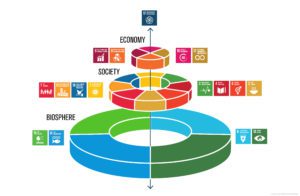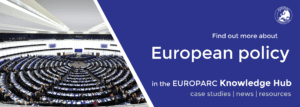The State of the European Union in the Protected Areas perspective
EU Commission President, Ursula von der Leyen by Arno Mikkor
In the State of the European Union address, the European Commission President Ursula von der Leyen presented the achievements and the challenges of the European Union and the plans for the coming year. How can we read this speech from the European Protected Areas perspective?
On the 16th of September, the European Commission President Ursula von der Leyen had her first SOTEU (State of the European Union) address to the European Parliament in Brussels. This important annual speech indicated the key topics and goals of the European Commission for the coming year.
A resilient environment
Referring to the extraordinary crisis of 2020, Ms von der Leyen’s vision for the next future is to move from fragility to resilience, in terms of human health, welfare, economy and sustainability. The latter being the main element of the European Green Deal, the President stressed the urgency of a transformation towards sustainability to protect “our fragile planet”. “The planet continued to get dangerously hotter” said Ursula von der Leyen. “We see it all around us: from homes evacuated due to glacier collapse on the Mont Blanc, to fires burning through Oregon, to crops destroyed in Romania by the most severe drought in decades”.
We know change is needed – and we also know it is possible. The European Green Deal is our blueprint to make that transformation.
The EU Green Deal aims to make Europe climate neutral by 2050. The President introduced a new ambitious target to reduce CO2 emissions by at least 55% before 2030. This reduction was an increase of 15% compared to the previous target. This increase is necessary, according to the European Commission, to meet the Paris agreement and UN SDG’s. The President stated that the EU impact assessment clearly shows that European economy and industry can manage this, and a large number of SME’s and some of the world’s biggest companies support this aim.
For us, the 2030 target is ambitious, achievable, and beneficial for Europe.
While the target is clear, it could be questioned which tools will be used to meet them and whether they will be met at all. Indeed, the European Parliament debate reflected the division between supporters of a strong EU commitment and who is sceptic or definitely against it.
Other important topics
Another challenge is to balance a sustainability transformation with economic growth and stability, which are also points of attention for the European Commission. “Never before has that enduring promise of protection, stability and opportunity been more important than it is today”. The recovery plan “NewGenerationEU” is based on these principles.
Another central topic in the address was health. The Covid 19 Pandemic should serve as a lesson for future health crises, and this experience shows the need of a stronger European Health Union: A union that is able to reserve more coordination and more funding for healthcare from the European level. Ms von der Leyen also underlined that a healthier and greener society go hand in hand.
But we also saw nature come back into our lives. We longed for green spaces and cleaner air for our mental health and our physical wellbeing.
In every topic that Ms von der Leyen mentioned, youth played a central part. The next generation is pushing for change in terms of a better planet, solidarity and human rights and they can teach a lot to adults and to the European Union.
The president also mentioned the digital acceleration we are now experiencing while working from home and that EU should takes the lead in this process, in terms of data, technology and infrastructure.
Other topics that Ms von der Leyen mentioned were the importance of European values and human rights, as well as the need of EU solidarity, especially, but not only, for the reception of immigrants and asylum seekers.
The long speech of Ms von der Leyen received several positive reactions. To make the ideas of the European Commissions into feasible plans, they will need support from the European Parliament and the Council of the EU. While some MEPs in the debate were critical, especially when it came to climate and sustainability, the majority declared their support. Also, the representative of the German Presidency of the Council of the EU, Michael Roth, showed broad support in his opening speech. He stressed the importance of cohesion between European institutions and having a common objective, in particular about climate change and environment.
Protected Areas perspective
From the Protected Areas perspective, we welcome the positive approach, the optimism and the commitments that permeated the speech. We would have liked to hear more about biodiversity protection and sustainable use of nature resources, as well as about marine environment and sea protection, in the framework of the EU Green Deal, nevertheless, we understand the need to touch also other topics that are crucial in the current debate in Europe. We can easily see how much all themes are connected with the Natura 2000 network and European Protected areas’ work.
Protected Areas are on the front line to look for and adopt new adaptive planning and governance tools accounting for Climate Change. In developing innovative methods, tools and services to perform climate change vulnerability assessment and develop adaptation plans, Protected Areas can indicate to other actors and territorial managers how to prevent and react to Climate change impacts.
Economic growth and nature conservation not only can, but should, be connected. The UN’s vision, assumed by the EU Green Deal, finally underlines clearly that no sustainable economic development –and a fair society- is possible without a healthy biosphere. Protected Areas are real laboratories where every day new solutions are explored for sustainable agriculture, sustainable fishery, sustainable tourism, revitalization of rural areas and creation of green jobs.

Sustainable Development Goals by Azote Images for Stockholm Resilience Centre
Human health is not possible without a healthy Planet, in terms of for example air quality and the quality of our food. Protected Areas provide what human being need in terms of mental and physical wellbeing. This is reflected well in the Healthy Parks Healthy People Europe Programme that was set up by the EUROPARC federation to support parks in this aspect.
Youth are not just our future leaders; they can provide a great support for nature conservation in protected areas today. We only have to give them a chance: EUROPARC and Protected Areas are absolutely convinced and committed to involve young generation, from the Junior Ranger program to the Aiguestortes-Declaration, from to the EUROPARC Youth Manifesto to the representative of youth in the EUROPARC Council. Moreover, next year there will be new elections for the Youth Council.
The European plans on digitalisation can open up new opportunity for remote and rural areas, and offer new tools for nature monitoring and territorial planning. Nevertheless, this process must be carefully implemented. We already see that the huge increase of social media provides important support in public awareness but also displays new challenges in Protected Areas management (as visitors’ flow management).
Last, but absolutely not least: European values and human rights. The address of Von der Leyen was referring not only to the terrible issues about rights protection of migrants, racism and discrimination against minorities, but also about democracy and right to expression. To guarantee the right of local communities to have a voice and to participate to the decisions about their own territory is an engagement for EUROPARC: The participatory approach, the dialogue with local stakeholders, the effort to build good partnership with different actors in the Protected Areas. These are all at the core of the EUROPARC programs and training.
The way forward
It is evident that Protected Areas are ready to be one of the keys players necessary to meet the sustainability targets of the EU. We can show both the public and the decision makers that investing in a transition towards a sustainable Europe is good for society, economy and the environment- “PROPELLING EUROPE FORWARD: BUILDING THE WORLD WE WANT TO LIVE IN” as the President of the European Commission encouraged in the SOTEU 2020.
